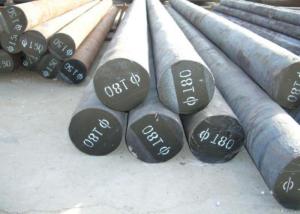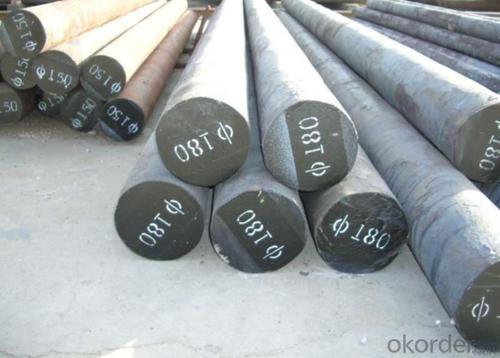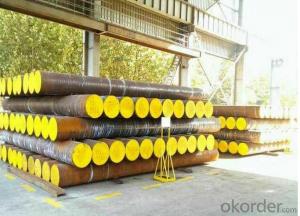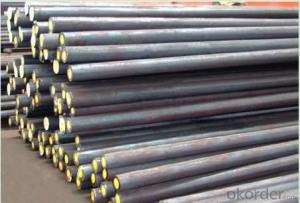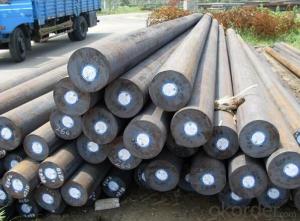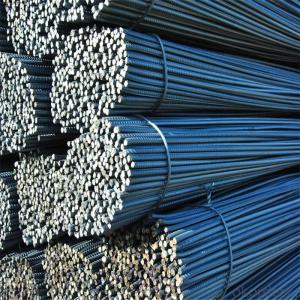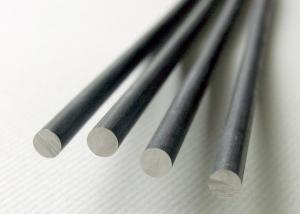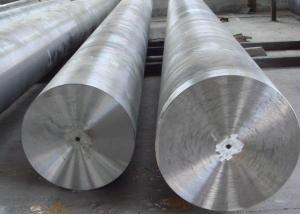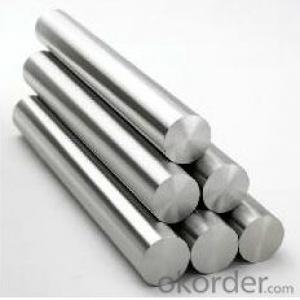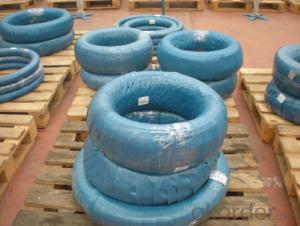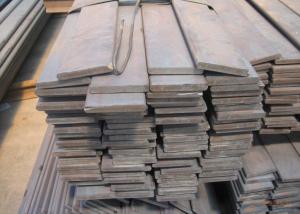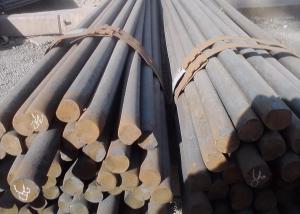Spring Steel 60Si2CrA
- Loading Port:
- China Main Port
- Payment Terms:
- TT or LC
- Min Order Qty:
- 50MT m.t.
- Supply Capability:
- 600000TONS/YEAR m.t./month
OKorder Service Pledge
OKorder Financial Service
You Might Also Like
Spring Steel:
Spring steel is divided into two types, one is alloy spring steel, and other one is carbon spring steel.
Alloy spring steel is a type that is used for manufacturing springs and other elastic parts. Spring steel should have high ratio of yield strength and tensile strength and elastic limit to make sure that the springs obtain enough power of elastic deformation and can bear much load.
Types of alloy spring steel: Si-Mn spring steel, Si-Cr spring steel, Cr-Mn Spring steel, Cr-V spring steel and so on.
Specification of Spring Steel 60Si2CrA
-Material: 60Si2CrA
-Standard: GB/T 1222-1984
-Type: Spring Steel
Corresponding Steel Grade for Reference:
CHN, GB | JPN, JIS | GER, DIN | GBR, BS |
60Si2CrA | SWOSC-V | 67SiCr5 | 685H57 |
USA, AISI/SAE/ASTM | ISO | ||
9254 | 55SiCr63 |
Chemical Composition:
C | Si | Mn | S |
0.52~0.60 | 1.5~2.00 | 0.60~0.90 | ≤0.035 |
P | Cr | Ni | Cu |
≤0.035 | ≤0.35 | ≤0.35 | ≤0.25 |
Mechanical Properties:
-Tensile Strength σb (MPa): ≥1274(130)
-Yield Strength σs (MPa): ≥1176(120)
-Elongation δ10(%): ≥6
-Percentage reduction of area: ψ (%): ≥30
-Hardness:
1, Hot rolled, ≤302HB
2, Cold drawn + Heat treatment: ≤321HB
-Norm of heat treatment: quenching 870℃±20℃
-Micro structure: Tempered troostite.
Usage/Applications of Spring Steel 60Si2CrA
-Compared with Si-Mn spring steel under the similar condition of plasticity, 60Si2CrA have higher tensile strength, yield strength and hardenability.
-60Si2CrA is applied for producing springs with working temperature below 300~500℃. This type of spring can bear high stress, for example, governor spring, turbine steam seal spring, etc…
Packaging & Delivery of Spring Steel 60Si2CrA:
-Packing Detail:
1, The products can be packed in bundles by steel wires.
2, The weight of each bundle no exceed normally 3 tons
-Marks: there are two types of marks. One is tag mark, for showing customers the specifications of products, company name and logo and other information required by customers. Other one is color marks. They are used to make the products more evident so that it’s easy for customers to distinguish them from other products at destination port.
-Delivery Detail: 30~45 working days after receive buyer’s T.T. or L/C.
Transportation:
-The products can be delivered by bulk vessel or by container. As for container, products with the length of 6m will be loaded in 20’ container, with 9m or 12m, in 40’ container.
-The maximum quantity of loading of container is 25 tons.
-The products are usually transported to the nearest port from the production place.
Payment:
-Invoicing on theoretical weight or actual weight as customer’s request.
-FOB, CFR or CIF.
-Terms of payment: T.T. or L/C at sight.
Photos of Spring Steel 60Si2CrA:
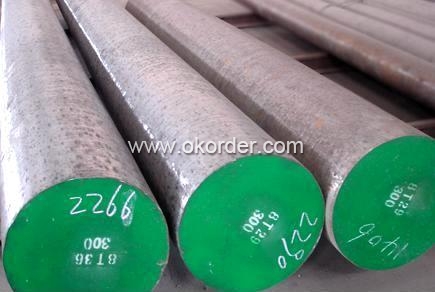
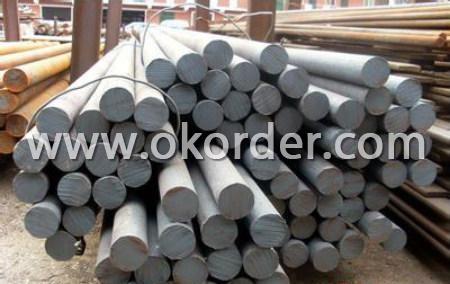
- Q:How is nitriding steel used in the manufacturing of engine components?
- Nitriding steel is used in the manufacturing of engine components to improve their hardness, wear resistance, and overall performance. The nitriding process involves diffusing nitrogen into the surface of the steel, forming a hard layer of nitrides. This increases the component's resistance to abrasion, corrosion, and fatigue, making it more durable and long-lasting. Additionally, nitrided steel has high heat resistance, which is crucial for engine components exposed to high temperatures and friction. Overall, the use of nitriding steel in engine manufacturing enhances the reliability and efficiency of the engine, leading to improved performance and longevity.
- Q:What are the safety benefits of using special steel?
- Several safety benefits can be obtained in various applications by using special steel. One of the key advantages lies in its superior strength and durability when compared to traditional steel. Special steel is often specifically designed to withstand extreme conditions, such as high temperatures or corrosive environments, making it highly suitable for industries like aerospace, automotive, and oil and gas. The enhanced strength of special steel allows for the construction of structures that are safer and more reliable. It can bear heavy loads, thus reducing the risk of structural failures or collapses. This is particularly crucial in industries where the utmost importance is placed on the safety of workers, equipment, and the general public. Resistance to corrosion is another safety benefit of special steel. Corrosion has the potential to weaken structures and compromise their safety. Special steel is frequently alloyed with elements like chromium, nickel, or molybdenum, which provide excellent resistance to corrosion. This makes it suitable for applications in marine environments, chemical processing plants, or any setting where exposure to moisture or chemicals is a concern. Special steel is also renowned for its ability to maintain its mechanical properties at high temperatures. This makes it an excellent choice for applications where resistance to heat is crucial, such as in the construction of fire-resistant structures or in the manufacturing of industrial ovens and furnaces. By utilizing special steel in these applications, the risk of structural failure or fire-related accidents can be significantly reduced. Furthermore, special steel can offer improved resistance to fatigue, which is of utmost importance in applications subject to cyclic loading or vibration. Fatigue failure can occur when a material experiences repeated stress over time, resulting in cracks and eventual failure. Special steel can be engineered to possess excellent fatigue properties, thereby reducing the likelihood of unexpected failures and enhancing the overall safety of structures or equipment. In conclusion, the safety benefits of using special steel encompass enhanced strength, durability, resistance to corrosion, resistance to heat, and resistance to fatigue. These properties establish special steel as a reliable choice for industries where safety is a primary concern, ensuring the protection of workers, equipment, and the general public.
- Q:How are cobalt-based alloys used in dental applications?
- Cobalt-based alloys are commonly used in dental applications due to their excellent mechanical properties, corrosion resistance, and biocompatibility. They are used in dental prosthetics, such as crowns, bridges, and dentures, as well as in dental implants. These alloys provide high strength and durability, ensuring long-lasting dental restorations. Additionally, their biocompatibility ensures that they do not cause any adverse reactions in the oral environment.
- Q:What are the different methods of heat treatment for special steel?
- There are several different methods of heat treatment for special steel, including annealing, normalizing, quenching, tempering, and case hardening. Each method involves heating the steel to a specific temperature and then cooling it in a controlled manner to achieve desired properties such as improved strength, hardness, toughness, or resistance to wear.
- Q:What are the different heat treatment techniques used for special steel?
- Some of the different heat treatment techniques used for special steel include annealing, tempering, quenching, and case hardening. Annealing is a process that involves heating the steel to a specific temperature and then slowly cooling it to relieve stress and improve its ductility. Tempering is done by reheating the steel to a lower temperature after quenching to reduce brittleness and increase toughness. Quenching is a rapid cooling process that involves immersing the steel in a quenching medium like oil or water to achieve high hardness. Case hardening is a technique that involves adding a hard outer layer to the steel by introducing carbon or nitrogen into its surface and then heat treating it to achieve desired properties. These techniques are used to modify the structure and properties of special steel to meet specific application requirements.
- Q:How does special steel perform under low temperatures?
- Special steel performs well under low temperatures due to its high ductility, toughness, and resistance to brittleness. It retains its strength and structural integrity, making it ideal for applications in extreme cold environments such as cryogenic storage, sub-zero manufacturing, and Arctic exploration.
- Q:Can special steel be used in the oil and gas industry?
- Yes, special steel can be used in the oil and gas industry. It is often utilized in the construction of pipelines, drilling equipment, and offshore platforms due to its high strength, corrosion resistance, and ability to withstand extreme temperatures and pressures.
- Q:What are the most common alloys used in special steel?
- The most common alloys used in special steel are stainless steel, high-speed steel, tool steel, and carbon steel.
- Q:What are the different methods of surface carburizing for special steel?
- Surface carburizing is a heat treatment process used to increase the carbon content at the surface of steel, resulting in a hardened outer layer. There are several methods of surface carburizing for special steel, each with its own advantages and disadvantages. 1. Gas Carburizing: This method involves exposing the steel to a carbon-rich gas, such as methane or propane, at elevated temperatures. The gas reacts with the steel surface, depositing carbon and forming a hardened layer. Gas carburizing is a widely used method due to its versatility, controllability, and ability to produce uniform and deep case depths. However, it requires specialized equipment and longer processing times. 2. Pack Carburizing: In this method, the steel is packed in a container with a carbon-rich material, such as charcoal or carbon powder. The container is then heated to high temperatures, allowing carbon to diffuse into the steel surface. Pack carburizing is a cost-effective method, but it is relatively slower and less controllable compared to gas carburizing. 3. Liquid Carburizing: Also known as cyaniding, this method involves immersing the steel in a liquid bath containing a carbon-rich compound, such as sodium cyanide. The bath is heated to high temperatures, which enables carbon diffusion into the surface of the steel. Liquid carburizing is a fast and cost-effective method, but it requires careful handling of toxic chemicals and may result in lower case depths compared to other methods. 4. Plasma Carburizing: This method utilizes a plasma discharge to provide a carbon-rich atmosphere around the steel surface. The plasma contains hydrocarbons, which dissociate into carbon atoms that diffuse into the steel. Plasma carburizing offers precise control over case depth and can achieve high surface hardness. However, it requires specialized equipment and is generally more expensive than other methods. 5. Salt Bath Carburizing: In this method, the steel is immersed in a molten salt bath containing carbon-rich compounds. The salt bath is heated to high temperatures, allowing carbon to diffuse into the steel surface. Salt bath carburizing is a versatile method that can achieve high case depths and excellent surface hardness. However, it requires careful temperature control and can be challenging to remove the salt residues after the process. It is important to select the appropriate method of surface carburizing based on the specific requirements of the special steel, such as desired case depth, hardness, and cost considerations.
- Q:What are the main environmental impacts of special steel production?
- The main environmental impacts of special steel production include emissions of carbon dioxide (CO2) and other greenhouse gases, energy consumption, deforestation (for charcoal used in the production process), water pollution (from the disposal of waste materials and chemicals), and habitat destruction due to mining activities. Additionally, the extraction and processing of raw materials for special steel production, such as iron ore and coal, can contribute to land degradation and ecosystem disruption.
1. Manufacturer Overview |
|
|---|---|
| Location | Jiangsu, China |
| Year Established | 1990 |
| Annual Output Value | Above US$ 20 Million |
| Main Markets | Mid East; Eastern Europe; North America |
| Company Certifications | |
2. Manufacturer Certificates |
|
|---|---|
| a) Certification Name | |
| Range | |
| Reference | |
| Validity Period | |
3. Manufacturer Capability |
|
|---|---|
| a)Trade Capacity | |
| Nearest Port | Shanghai |
| Export Percentage | 20% - 30% |
| No.of Employees in Trade Department | 21-50 People |
| Language Spoken: | English; Chinese |
| b)Factory Information | |
| Factory Size: | Above 100,000 square meters |
| No. of Production Lines | 1 |
| Contract Manufacturing | OEM Service Offered; |
| Product Price Range | High; Average |
Send your message to us
Spring Steel 60Si2CrA
- Loading Port:
- China Main Port
- Payment Terms:
- TT or LC
- Min Order Qty:
- 50MT m.t.
- Supply Capability:
- 600000TONS/YEAR m.t./month
OKorder Service Pledge
OKorder Financial Service
Similar products
New products
Hot products
Hot Searches
Related keywords
